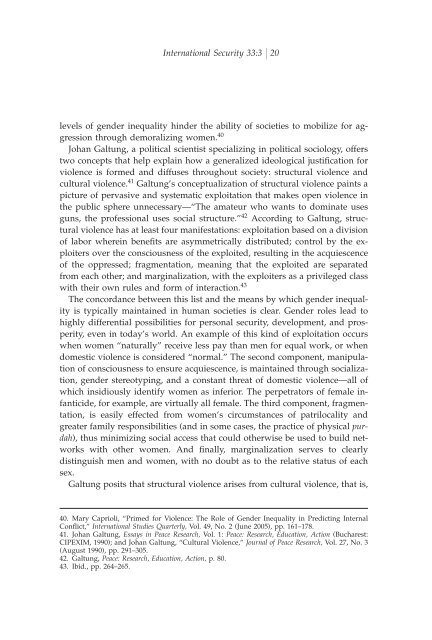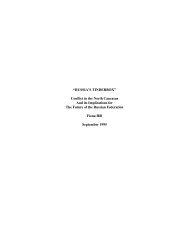The Heart of the Matter Valerie M. Hudson, - MIT Press Journals
The Heart of the Matter Valerie M. Hudson, - MIT Press Journals
The Heart of the Matter Valerie M. Hudson, - MIT Press Journals
You also want an ePaper? Increase the reach of your titles
YUMPU automatically turns print PDFs into web optimized ePapers that Google loves.
International Security 33:3 20<br />
levels <strong>of</strong> gender inequality hinder <strong>the</strong> ability <strong>of</strong> societies to mobilize for aggression<br />
through demoralizing women. 40<br />
Johan Galtung, a political scientist specializing in political sociology, <strong>of</strong>fers<br />
two concepts that help explain how a generalized ideological justiªcation for<br />
violence is formed and diffuses throughout society: structural violence and<br />
cultural violence. 41 Galtung’s conceptualization <strong>of</strong> structural violence paints a<br />
picture <strong>of</strong> pervasive and systematic exploitation that makes open violence in<br />
<strong>the</strong> public sphere unnecessary—“<strong>The</strong> amateur who wants to dominate uses<br />
guns, <strong>the</strong> pr<strong>of</strong>essional uses social structure.” 42 According to Galtung, structural<br />
violence has at least four manifestations: exploitation based on a division<br />
<strong>of</strong> labor wherein beneªts are asymmetrically distributed; control by <strong>the</strong> exploiters<br />
over <strong>the</strong> consciousness <strong>of</strong> <strong>the</strong> exploited, resulting in <strong>the</strong> acquiescence<br />
<strong>of</strong> <strong>the</strong> oppressed; fragmentation, meaning that <strong>the</strong> exploited are separated<br />
from each o<strong>the</strong>r; and marginalization, with <strong>the</strong> exploiters as a privileged class<br />
with <strong>the</strong>ir own rules and form <strong>of</strong> interaction. 43<br />
<strong>The</strong> concordance between this list and <strong>the</strong> means by which gender inequality<br />
is typically maintained in human societies is clear. Gender roles lead to<br />
highly differential possibilities for personal security, development, and prosperity,<br />
even in today’s world. An example <strong>of</strong> this kind <strong>of</strong> exploitation occurs<br />
when women “naturally” receive less pay than men for equal work, or when<br />
domestic violence is considered “normal.” <strong>The</strong> second component, manipulation<br />
<strong>of</strong> consciousness to ensure acquiescence, is maintained through socialization,<br />
gender stereotyping, and a constant threat <strong>of</strong> domestic violence—all <strong>of</strong><br />
which insidiously identify women as inferior. <strong>The</strong> perpetrators <strong>of</strong> female infanticide,<br />
for example, are virtually all female. <strong>The</strong> third component, fragmentation,<br />
is easily effected from women’s circumstances <strong>of</strong> patrilocality and<br />
greater family responsibilities (and in some cases, <strong>the</strong> practice <strong>of</strong> physical purdah),<br />
thus minimizing social access that could o<strong>the</strong>rwise be used to build networks<br />
with o<strong>the</strong>r women. And ªnally, marginalization serves to clearly<br />
distinguish men and women, with no doubt as to <strong>the</strong> relative status <strong>of</strong> each<br />
sex.<br />
Galtung posits that structural violence arises from cultural violence, that is,<br />
40. Mary Caprioli, “Primed for Violence: <strong>The</strong> Role <strong>of</strong> Gender Inequality in Predicting Internal<br />
Conºict,” International Studies Quarterly, Vol. 49, No. 2 (June 2005), pp. 161–178.<br />
41. Johan Galtung, Essays in Peace Research, Vol. 1: Peace: Research, Education, Action (Bucharest:<br />
CIPEXIM, 1990); and Johan Galtung, “Cultural Violence,” Journal <strong>of</strong> Peace Research, Vol. 27, No. 3<br />
(August 1990), pp. 291–305.<br />
42. Galtung, Peace: Research, Education, Action, p. 80.<br />
43. Ibid., pp. 264–265.
















